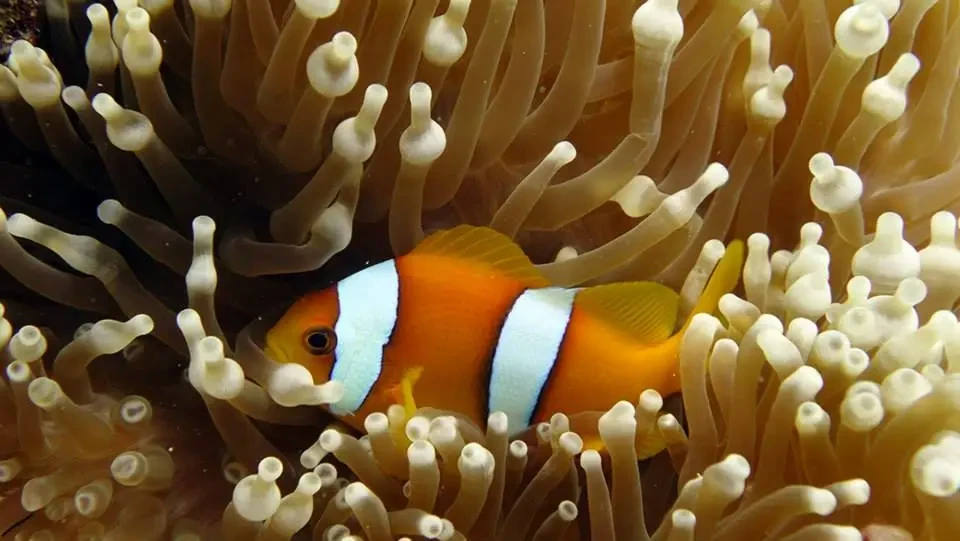Clown of the Chagos Archipelago (Amphiprion chagosensis) is a rare member of the pomecenter family (Pomacentridae), which lives only in the waters of the Chagos Archipelago in the Indian Ocean. It is distinguished by golden-brown coloration, one white stripe and a strong symbiosis with sea anemones.
✔ Rare endemic to the Chagos Archipelago
✔ A dedicated partner of anemone polyps
✔ It has an interesting social structure where the male can change gender
✔ A little-known and little-studied species
Despite its low popularity in the world, this species plays an important role in the coral reef ecosystem and it is part of the natural balance of the Indian Ocean.

Scientific classification
✔ The Kingdom: Animals (Animalia)
✔ Type: Chordal (Chordata)
✔ Class: Lucheperi pisces (Actinopterygii)
✔ Row: Perch-like (Perciformes)
✔ Family: Pomacentrovye (Pomacentridae)
✔ Gender: Amphiprions (Amphiprion)
✔ View: Amphiprion chagosensis
✔ Described: Allen, 1972
This species got its name in honor of the place of residence-the Chagos Archipelagolocated in the central Indian Ocean.
Habitat and habitat
🌏 Distribution:
🔹 Endemic to the Chagos Archipelago
Живет Lives exclusively on the reefs of this region
🏝 Living environment:
, Tropical coral reefs at depths of 2-25 m
Предпочитает Prefers warm, clean waters with a temperature of 24–29°C
💥 Closely related to sea anemones, such as Heteractis magnifica and Stichodactyla gigantea
The clown of the Chagos Archipelago is very territorial fishprotecting its anemone and its habitat.
Appearance and coloring
🔸 Main Features:
✔ The body is dark brown or tan
✔ One white vertical stripe on the head
✔ The abdomen and fins are yellowish in color
✔ Average size-8-11 cm, maximum - up to 12 cm
🔸 Sexual dimorphism:
✔ Females larger than males
✔ If the female dies, the largest male is turns into a female
This color helps the fish disguise yourself among the corals anemone, reducing the risk of being seen by predators.
Lifestyle and behavior
✅ Symbiosis with anemones
✔ Uses anemone's stinging tentacles for protection
✔ Secretes a special slime that makes it immune to anemone burns
✔ Cleanses the anemone from food residues
✅ Social structure
✔ Live small groups of 2-5 individuals
✔ The dominant individual is the female
✔ If the female dies, the largest male changes sex
✅ Territoriality and behavior
✔ Very much aggressively protects the anemone
✔ Attacks small fish that swim too close
✔ Doesn't migrate, spends his entire life near one anemone
Food
🔹 Basic diet:
✔ Zooplankton
✔ Small crustaceans
✔ Seaweed
🔹 Nutrition features:
✔ Omnivorous fish that combines plant and animal foods
✔ Can eat leftover anemones
The clown's diet depends on the environmentwhich makes it flexible in your eating habits.
Reproduction
🔹 Proteroginal hermaphrodite:
✔ Born as a male, but can change the gender
🔹 Spawning process:
✔ Female lays eggs 200-1000 eggs
✔ Caviar is attached to stones near the anemone
✔ The male guards the clutch up to 10 days, after which the larvae hatch
Larvae spend the first 10-14 days in the water columnbefore settling on the reef.

Predators and threats
🔸 Natural enemies:
✔ Large predatory fish
✔ Predatory crustaceans
🔸 Threats to the public:
✔ Climate change and the destruction of coral reefs
✔ Fish catch for aquariums
✔ Ocean pollution
Clown of the Chagos Archipelago depends on the health of the reefstherefore, their destruction threatens its existence.
Keeping in aquariums
🟠 Popularity:
✔ Very much rare on sale
✔ Needs specific conditions of detention
🟠 Aquarium requirements:
✔ Volume: 150 + liters
✔ Temperature: 24–28°C
✔ Salinity: 1.020–1.025
✔ The presence of an anemone is desirable
🟠 Compatibility:
✔ Peaceful sea fish
❌ You can't keep it with other clownfish!
This view is suitable only for experienced aquarists, because it needs proper care and stable water conditions.
Interesting facts
🔹 One of the least studied clownfish
🔹 Endemic to Chagos - not found anywhere else in the world
🔹 It can live up to 12 years in the wild
🔹 Protects the anemone even from humans
Conclusion
Clown of the Chagos Archipelago (Amphiprion chagosensis) – a unique species of clownfisha person who lives in only one region of the world. Its life is closely linked to coral reefs, and the preservation of its population depends on the ecological stability of the ocean.
📢 Protecting coral reefs is the only chance to preserve this rare species! 🌊🐠💙